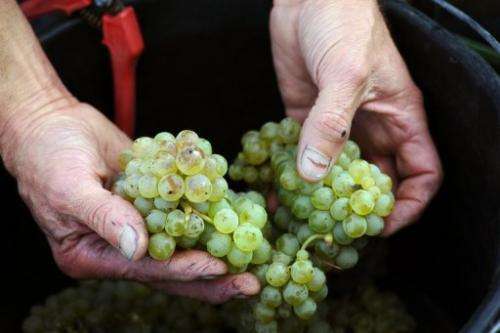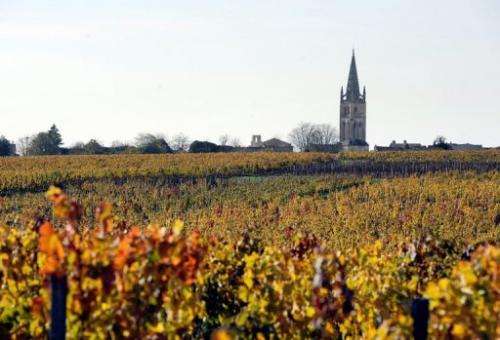France 2012 wines include both beauties and beasts

There will be some beauties to be found—but you may first need to kiss a few toads.
Such, anyway, is the experts' early verdict on the prospects for France's 2012 vintages, after what has been a testing year marred by dismal harvests.
Some regions report remarkable, though scarce, wines, and Bordeaux saw its hopes for another stellar vintage washed away by October rains.
"It was complicated. We were eight to 10 days from a really great vintage. There was significant advantage for the Merlot and early-ripening terroirs. Pomerol will be magnificent," said Stephane Derenoncourt, a consulting winemaker.
It all comes down to grape variety, terroir (a combination of soil, climate, grape and savoir-faire) and how well the grower managed the crop.
"It's not an easy vintage to describe—there's a lot of variability," said Yann Le Goaster, director of the Federation des Grands Vins de Bordeaux.
Bordeaux's dry white wines, picked well before the rainy spell, show great potential.
"I am enchanted by the white wines," said Denis Dubourdieu, consultant and director of Bordeaux's Institute of Wine and Vine Sciences.
But the difficult growing season pushed the harvest for the late-ripening Cabernet Sauvignon grape, the backbone of Bordeaux's red blend, back into October. Unripe Cabernet Sauvignon grapes are full of herbaceous and green pepper aromas.
"This was another abnormal vintage. We had a horribly wet spring, then from mid-July to September 20th, extremely dry. That's complicated," Dubourdieu said.
Then grey skies opened, and unrelenting downpours had growers racing to collect crops as rot spread.
"It was very intense, there were a lot of grapes picked over eight days," said Jean-Christophe Crachereau, oenologist at the Gironde Chamber of Agriculture.
They had reason to rush. Once established in the bunches, rot introduces an enzyme that destroys the fresh, fruity aromas and causes red wine to lose colour, says Crachereau.
"There was sufficient ripeness in most cases. The pips were ripe, so we don't have bitterness and astringency. We were lucky that September was beautiful, with a lot of diurnal variation in temperature. This synthesises the anthocyanins, which gives a richer colour," Crachereau said.

"It's not an exceptional vintage like 2005, 2009 or 2010. It's not a concentrated wine, but the colour is intense and the aromas are intensely fruity and fresh."
The gamble taken this year in Bordeaux is the same everywhere, every year, said Ithier Bouchard, director of Tariquet, located in Gascony, a few hours from Bordeaux.
"We take the risks to get optimal maturity. It's a risk everywhere. It's a question of saving the harvest in volume or waiting for ideal maturity and having to sort and lose some volume."
Tariquet produces eight million bottles from 900 hectares (2,220 acres). "With the amount of land we have, we can take some risks. We always have something left," Bouchard said.
Bouchard said that yields were down in a proportion similar to Bordeaux—estimates range from five to 20 percent.
But elsewhere in France marvellous quality and distressingly low yields seem to be the hallmark of this vintage.
"We had a difficult year—frost in April which hit the early-ripening plots of premier and grand cru, significantly lower yields. Then May, June and July were wet. But from mid-July to August we had good weather which delivered grapes in perfect health and excellent ripeness," said Didier Seguier, director of William Fevre, the largest grand cru owner in Chablis.
Seguier said he was more than satisfied with the quality.
"The first vats of wine are showing purity, precision and freshness. It's surprising to have so much freshness given the average, even low, acidity," said Seguier.
Burgundy producers say their wines are often remarkable, but supply is scarce—particularly in the famous Cote de Beaune, with yields down 50 to 70 percent, according to Burgundy Wine Council president Michel Baldassini.
In the south of the appellation, Beaujolais faces the lowest yields in recent memory—down 50 percent.
"Everyone has said they have low or very low yields," said Jean Bourjade, general manager of the Inter-Beaujolais wine council. "But we are happy with the quality. The berries were small, giving stronger, more defined aromas and a better expression of fruit."
Consumers will feel the immediate pinch of low yields when the popular Beaujolais Nouveau hits stores around the planet on November 15th.
"We will be giving priority to our main markets," said Bourjade.
In Champagne, early reports announce an outstanding vintage for bubbly, but yields are down 30 percent from 2011, making them the lowest in 20 years.
"The vines suffered every possible disaster up to the middle of the summer," said Champagne wine board spokesman Thibault Le Mailloux. "We feared the worst but August turned things around."
Heading south, the Rhone Valley was one of the rare regions to escape nature's vagaries.
"The Rhone region was mainly influenced by a Mediterranean climate, while the rest of France was subject to oceanic influences," explained Michel Chapoutier, vice-president of Inter-Rhone.
"The Rhone harvest went well," said Derenoncourt. "The vintage is very rich, generous and shows beautiful ripeness."
Yields held steady and early tastings show highly expressive, well-balanced wines.
"On initial tasting, our Syrahs display pepper, violets and liquorice, with beautifully supple enrobed tannins," reports Andre Perret, producer of Condrieu and Saint-Joseph.
(c) 2012 AFP

















